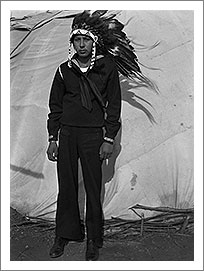 |
|||||||||
|
January/February 2017 For a Love of His People: The Photographs of
Poolaw was a Kiowa born in 1906 (a year before Oklahoma became a state), and spent his life in and around Anadarko, in the state’s southwestern plains, among the Kiowa and the other tribes that had been tossed together by federal fiat. In the course of a half-century career, he took thousands of photographs, but was only exhibited once. It was a time of rapid technological and cultural change, and Poolaw documented those changes with affection, pride, and humor—but without sentimentality. After years of being forbidden to wear traditional clothing, new interest in the Wild West resulted in shows in many western towns. These tourist attractions wanted to include Indians, and the demands of commerce undermined government edicts. Poolaw was there to photograph his neighbors in traditional attire. And he was there, too, when they incorporated elements of white culture. Horace Poolaw was both spectator and participant. By and large, his subjects were his friends, children, and neighbors. He was committed, wrote Martha A. Sandweiss, “to capturing a record of Kiowa life in the rapidly changing landscape of twentieth century America.”
Instead of the hostile reception experienced by so many when they returned from Vietnam, Kiowa veterans were showered with gifts and participated in honor dances (left). “American Indians come home to welcome powwows and dances, big giveaways in your honor, a big pat on the back,” said Robert W. Poolaw, another of Horace’s sons. “You are a welcome hero. No one has ever said anything bad about being in Vietnam, perhaps because of that warrior heritage and that warrior tradition. It’s like coming home from a big raid.”
|
|||||||||
|
|
|||||||||
The Military Working Dog Commemorative Stamp Drive needs your help. |
|||||||||
8719 Colesville Road, Suite 100, Silver Spring. MD 20910 | www.vva.org | contact us |
|||||||||





















 Long before Horace Poolaw picked up a camera, an artistic tradition had developed—best exemplified by photographer Edward Curtis and painter George Catlin—of depicting the “Vanishing Indian,” whose culture and race would soon slip into the mists of history. Poolaw, however, had no intention of vanishing.
Long before Horace Poolaw picked up a camera, an artistic tradition had developed—best exemplified by photographer Edward Curtis and painter George Catlin—of depicting the “Vanishing Indian,” whose culture and race would soon slip into the mists of history. Poolaw, however, had no intention of vanishing..jpg) A major retrospective of his work is on display at the National Museum of the American Indian in Washington, D.C., through June 4. It’s a loving portrait of a community and culture, and includes photographs of many veterans of three wars. Poolaw served in the U.S. Air Force; his son Jerry (above) served in the Navy.
A major retrospective of his work is on display at the National Museum of the American Indian in Washington, D.C., through June 4. It’s a loving portrait of a community and culture, and includes photographs of many veterans of three wars. Poolaw served in the U.S. Air Force; his son Jerry (above) served in the Navy.